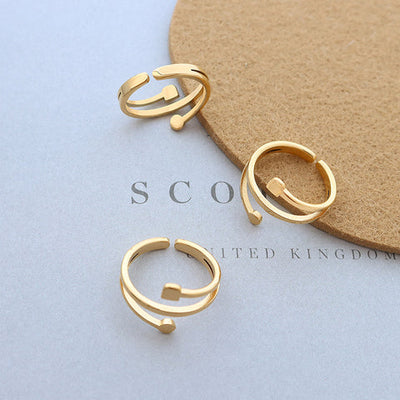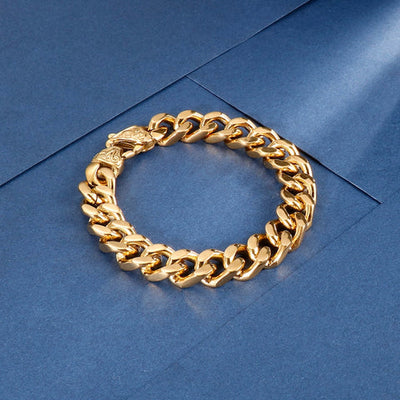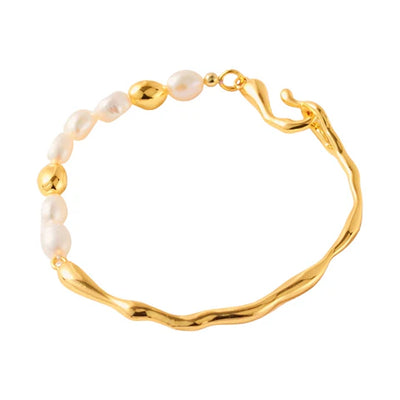Have you ever noticed your once-shiny silver rings turning a weird copper, making you wonder what’s going on? Well, it’s not your imagination but a common issue most people experience, including businesses in the jewelry industry.

This color change often happens because of the metals mixed with silver in your accessories palace. Most silver jewelry is actually made from sterling silver, which is a blend of 92.5% silver and 7.5% other metals, like copper.
Over time, the copper can react with moisture and stuff in the air, causing your ring to tarnish and change color.
So, If you’re worried about “Why is My Silver Ring Turning Copper”, know that It's completely normal and by addressing the causes and preventing discoloration, you can keep your silver pieces looking beautiful and ensure customer satisfaction.
Let’s dive deeper into this issue and explore solutions for better business deals!
Understanding the Composition of Silver Jewelry
When it comes to silver jewelry, be it your silver beaded necklaces or bridal jewelry sets, many people assume their pieces are made of 100% silver. However, the reality is a bit different, and understanding the composition can explain why your beloved accessory might develop an unexpected copper hue.
The truth is when you buy a silver ring, it's actually what we call sterling silver. That means it's only 92.5% pure silver. The other 7.5% is usually copper.
So, why mix copper with other metals? Well, The addition of copper is crucial for a couple of reasons:
Enhancing Durability: Pure silver is indeed beautiful but can be pretty soft and easily scratched or bent. Mixing in copper makes the silver quite stronger and way more durable. This means your sterling silver jewelry can handle daily wear without losing its shape or getting damaged.
Facilitating Design: Copper also makes silver easier to work with, which is great for creating intricate designs. It allows jewelers to craft those detailed patterns and shapes you love, which would be tricky to do with pure silver alone. So next time you admire the fine details of a silver ring, remember it’s copper that helps make those stunning designs possible!
So, Why Does Silver Jewelry Change Color?
The reason behind your silver ring starting to change color is typically a cause of these:
Reaction With Moisture and Air: Over time, the copper in your sterling silver reacts with moisture and air. This reaction forms copper compounds like copper oxide or copper carbonate, which can make your silver ring look dull or tarnished. So if your shiny ring starts to look different, that’s likely why.
Environmental Factors: Some things in your environment can speed up tarnishing. High humidity, sulfur compounds (which can be in polluted areas), or even certain chemicals can make tarnishing happen faster. Keeping your silver away from these elements can help keep it looking its best.
Chemical Reactions Leading to Discoloration
So, when you start to see your silver jewelry look different over time, all it comes down to the common chemical occurrence between the metal and the environment, primarily oxidation and sulfidation
Understanding these reactions requires some scientific knowledge. Let's delve into the two main culprits: oxidation and sulfidation.

Oxidation
It’s a chemical reaction that usually appears when silver comes in contact with the oxygen in the air. Think of it like rusting but for silver.
This process creates a thin layer of silver oxide on the surface of your ring. At first, this layer is transparent, but as it thickens over time, it can make your ring look dull or even give it a yellowish tint.
Sulfidation
Now, Sulfidation is another chemical reaction that occurs when silver interacts with sulfur or sulfur-containing compounds. This is a big cause of tarnishing in silver jewelry and can lead to noticeable discoloration over time.
Normally, Sulfidation tends to be worse in places with high sulfur content, like polluted cities or near industrial sites. In such areas, sulfur dioxide (SO2) and other sulfur gases are common, which makes silver tarnish faster. So, if you live or work in one of these environments, you might notice your silver jewelry getting discolored more quickly.
Environmental Factors Affecting Discoloration
Noticing your silver getting an absurd color isn’t just about chemistry–it’s also about the environment. Anything that exposes silver to more sulfur can make it tarnish quicker. So let’s discuss them simply through this table.
|
Factor |
Effect on Discoloration |
|
Humidity |
High humidity levels accelerate both oxidation and sulfidation. |
|
Pollution |
Pollutants in the air, like sulfur oxides, can increase the rate of sulfidation. |
|
Exposure To Chemicals |
Everyday stuff like perfumes, lotions, and cleaning products can react with silver and copper, making them tarnish faster. Even chlorine in swimming pools can be a culprit. |
So, to keep your silver jewelry looking its best, try to store it in a dry, clean place and give it a regular clean with the right solutions.
Understanding the Science of Discoloration: Implications for Jewelry Businesses
When you’re in this jewelry business, understanding the science behind this silver losing its shine can totally be a game-changer for you. So, It's not always about selling shiny stuff; it's more about being the go-to expert for all things silver.
Imagine this: your customer comes in, all worried because their favorite silver ring is looking a bit, well, yucky. Instead of just saying "Oh, that happens," you drop some knowledge on them about how silver and air aren't exactly a good match. You explain that sometimes silver gets a little moody and likes to turn colors, but it's totally normal.
Here are some of the ways of how you can leverage this knowledge to enhance customer service and satisfaction:
How Does It Matter for Businesses?
- Quality Control: Understanding the process of discoloration in your silver rings can greatly help you make sure your pieces stay in great shape. By knowing what causes tarnish, you can pick better materials or treatments that help keep your products looking shiny and new for longer.
- Design and Material Choices: With this knowledge, you can design jewelry and choose materials that are less likely to tarnish. For example, using coatings or special treatments to protect against tarnishing can make your pieces more durable and appealing to customers.
How does It help Boost Customer Satisfaction?

- Educate Your Customers: Tell them why their silver jewelry tarnishes and how it’s a natural process. Explain it in a friendly, easy-to-understand way, so they feel informed and reassured.
- Offer Solutions: Suggest practical solutions for tarnish prevention, like anti-tarnish pouches or cleaning products. By offering these products or recommendations, you show that you care about keeping your customers’ jewelry looking its best.
- Handle Concerns: When customers come to you with tarnishing issues, your understanding of sulfidation means you can offer solid advice and reassurance. Help them with effective cleaning methods and maintenance tips to keep their jewelry looking great.
- Stand Out in the Market: By taking the time to explain things and offer helpful tips, you’re showing your customers that you care about them and their jewelry. This creates a positive experience and keeps them loyal to your brand.
Preventive Measures and Solutions
Keeping your silver jewelry looking great is all about a little care and the right tools. Here’s how you can prevent tarnish, protect your pieces, and restore them if they get a bit dull.
1. Prevention Tips
Store it Right: When you’re not wearing your silver jewelry, try to store it in airtight containers or special anti-tarnish pouches. These small jewelry boxes are designed to soak up moisture and sulfur, which are big culprits in tarnishing. Also, try keeping individual items separated from others in padded containers or linings to protect stones from scratches and other damage when stored over long periods.
Avoid Chemicals: Keep your silver accessories away from harsh chemicals like chlorine or bleach. They can accelerate the tarnishing so, remember to take off your jewelry before swimming or using strong cleaning products.
Clean Regularly: Give your silver jewelry a gentle wipe with a soft cloth to remove dirt and oils. For a deeper clean, use a silver polish that's made for jewelry. Just make sure it’s gentle so you don’t scratch the surface.
Wear It Often: Believe it or not, wearing your silver jewelry can actually help keep it shiny. The natural oils from your skin help protect it. Just be sure you’re not exposing it to chemicals.
2. Recommended Products and Treatments
Anti-Tarnish Pouches and Cloths: These are lifesavers for preventing tarnish. Anti-tarnish pouches and cloths are designed to keep your jewelry safe by absorbing the sulfur and moisture that cause tarnishing.
Silver Polishes: For a quick shine-up, silver polishes can do wonders. Look for ones that are safe for jewelry and follow the instructions carefully.
Cleaning Solutions: If your jewelry is looking a bit worse for wear, silver cleaning solutions can help. Just be sure to follow the directions and test on a small area first to make sure it’s safe.
3. Restoring Tarnished Silver Jewelry

DIY Cleaning: If your silver has already tarnished, you can try some easy home fixes. A paste made from baking soda and water works well. Just rub it on the tarnished spots with a soft cloth, rinse, and dry.
Commercial Cleaners: For tougher tarnishes, commercial silver cleaners are effective. These cleaners are specifically formulated to get rid of copper discoloration on jewelry, as well as any other metallic buildup or dirt residue on the piece.
Professional Help: If your jewelry is really tarnished or has intricate details, an experienced jeweler can thoroughly clean it and restore its shine.
With these tips, you can keep your silver jewelry looking fantastic and deal with tarnishing easily if it happens.
Marketing Strategies Around Tarnish Prevention
Do you know that your knowledge of silver discoloration can be a powerful marketing tool? Yes. Leveraging this information can actually set your jewelry business apart and build stronger customer relationships.
1. Educating Customers Through Workshops Or Care Guides.
Host Workshops: How about hosting some fun, hands-on workshops? Whether in-store or online, these sessions can teach your customers how to care for their silver jewelry. Show them how to clean it, store it properly, and prevent tarnishing. It’s a great way to build a connection with your customers and show them you’re the go-to expert for jewelry care.
Create Care Guides: Put together simple care guides that customers can use at home. Include tips on keeping silver shiny and avoiding tarnish. Hand these out with purchases, post them on your website, or include them in your email newsletters. It’s a helpful way to give customers confidence in caring for their jewelry and keep them loyal to your brand.
2. Promoting Anti-Tarnish Products Or Offering Cleaning Services As A Value-Added Service.
Promote Anti-Tarnish Products: Show off your anti-tarnish products like small jewelry boxes, pouches, and cleaning solutions in your marketing. Let your customers know how these can help keep their silver jewelry looking fabulous. You might even bundle them with purchases or include them in special promotions. It’s a win-win: you boost sales and give customers handy tools to protect their jewelry.
Offer Cleaning Services: Make cleaning services a special perk for your customers. Offer professional cleaning to restore tarnished jewelry and keep it sparkling. You could include these services in a loyalty program or as a freebie with certain purchases. It’s a great way to provide extra value and convenience to your customers.
3. Showcase Your Expertise and Engage with Customers
Show Off Your Knowledge: Share your expertise on tarnish prevention through blog posts, social media, and ads. Give out useful tips and advice to show you know your pieces. This helps build trust and positions your brand as the go-to for jewelry care.
Engage with Your Audience: Get interactive with your customers. Encourage them to ask questions about jewelry care and share their own tips. Chat with them on social media or through customer service to provide personalized advice. It’s a great way to build a community and make your customers feel valued.
Conclusion
While it might be frustrating to see your favorite silver ring turning copper, know that it’s all due to oxidation and other environmental influences.
Now, understanding these scientific occurrences is imperative for both jewelry enthusiasts and businesses.
It helps you grasp the causes and the ways to fix them. So, whether you’re someone trying to keep your ring looking great or a business aiming to provide the best advice and products, knowing the ins and outs of tarnishing can make a big difference.
So, it’s better you know what’s up with your silver ring. Just follow some simple care tips, use the right products, and you’ll keep your jewelry looking fabulous.
Trixmall.com offers a treasure trove of resources to help your business shine. From dealing in sophisticated jewelry pieces to finding the latest tools and trends, it has you covered. So, let’s get in touch now and explore the beauty of working together to elevate your business to new heights.
Frequently Asked Questions
1. Is Tarnishing Different From Rust?
Yes, tarnishing and rusting are different. Tarnishing happens when metals like silver get a dull coating from reacting with moisture in the air. Rusting is when iron reacts with oxygen and moisture, forming that flaky red stuff we see on old nails and cars. Both involve oxidation, but they affect different metals and look different.
2. How Quickly Does Silver Jewelry Tarnish?
Silver jewelry can start to tarnish depending on how well you treat it. It gets pretty affected (say tarnish)—sometimes in just a few days or up to a couple of weeks. It mostly depends on things like humidity and how frequently you wear it. The more it’s exposed to these factors, the faster it’ll tarnish.
3. What’s the Difference Between Pure Silver And Sterling Silver?
Pure silver, or fine silver, is almost all silver—99.9% to be exact. Because it’s so pure, it doesn’t tarnish as quickly. Tarnishing silver, or sterling silver, is mostly silver too (92.5%), but it’s mixed with other metals like copper to make it stronger and more durable. This mix makes it more likely to tarnish over time, so you might need to clean it more often to keep it looking shiny.










